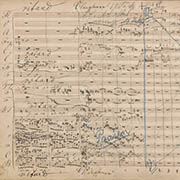Bruckner’s “Romantic” Symphony is one of his best-known works. The new critical edition is based for the first time on all the surviving manuscript sources and reconstructs the version of the first performance of 1881.
Bruckner’s Symphony No. 4 has long been one of his most popular works. Although it is well-known to almost every music-lover, important aspects of its history and its musical text have remained shrouded in mystery for decades. But this could all now change: the new critical edition of the second version of the symphony is the first to be based on an intensive comparative examination of all surviving manuscript sources, including the full score and orchestral parts of the first performance by the Vienna Philharmonic under Hans Richter on 20 February 1881. Hence this edition differs in several important respects from the edition by Robert Haas and Leopold Nowak available until now.
The new edition represents the version of the symphony which was played at the first performance in 1881. The musical text therefore contains some alterations which were made during rehearsals and which were clearly regarded by the composer as improvements. However, Bruckner’s late additions to the orchestration of some passages in 1886 have not been incorporated into the main text. Of course the edition also corrects some wrong notes and misinterpreted notation as found in older scores.
In contrast with the Haas edition, the new edition contains the musically important change of meter in the Finale, as was used for the first time at the 1881 performance. As well as this it explains and clarifies Bruckner’s intended tempo scheme, which is not presented clearly in the two preceding editions. Consequently, the new edition will contribute to future performances being given with tempi which relate to each other; these divide this exceptionally complex musical structure and are indispensable if its full effect is to be achieved.
The Editorial Report for the edition discusses in more detail and more precisely than ever before Bruckner’s compositional and revision process of this version, from the creation of the work in 1877, through the first performance of 1881 to the last alterations of 1886. For the first time, most importantly the complex sequence of revisions which Bruckner undertook at the end of the development and the beginning of the reprise of the finale before and after the first performance is explained. The Appendix to the edition contains the variant of this passage, as attempted by Bruckner in the years 1880 and 1881. Likewise, a passage cut from the Andante, and all other alterations made by Bruckner in 1886 are published in the Appendix. The early variant readings of several passages which the composer revised in 1881 are similarly described in the Editorial Report.
For all these reasons, this new critical edition is undoubtedly the clearest and most comprehensive representation to date of the musical text and the compositional history of the most frequently performed version of this popular symphony, a work which still remains partly misunderstood.
Benjamin Korstvedt
[from [t]akte 1/2018]



